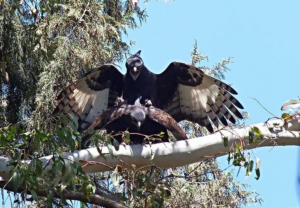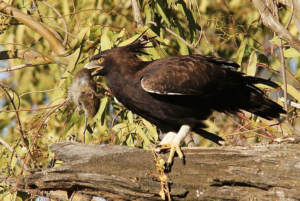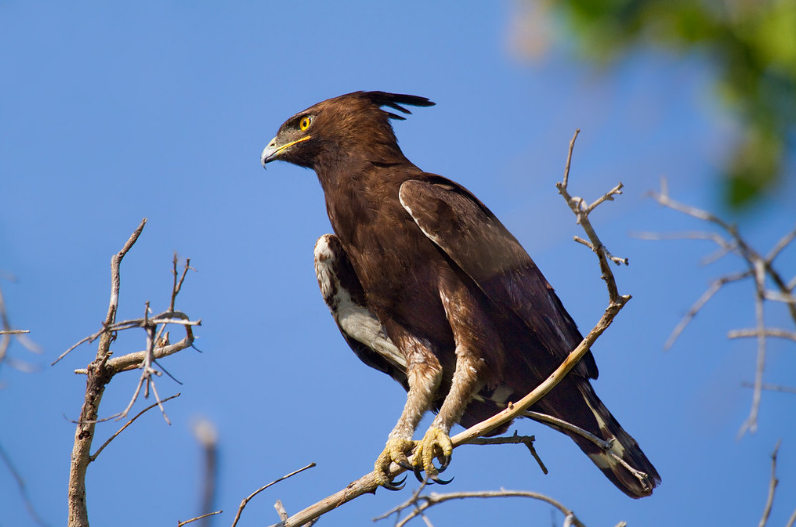Long Crested Eagle | Uganda birds
Long Crested Eagle | Uganda birds : is basically small to medium-sized African bird of prey in the family Accipitridae and lives throughout Africa. In fact, this bird derives its name from its peculiar long, shaggy crest at the prance of their crown. Scientifically, is called “Lophaetus occipitalis” while in Luganda Uganda local language its “Kamusungu-sungu”. These birds are generally noisy, particularly during the breeding season and their calls include a high-pitched scream and a repetitive “kik kik kik”. On the other hand, they are believed to have prophetic abilities in foretelling marriages. You ask where you will get a bride or groom and the direction it turns is the source of the mate.
Physical description
These eagles generally have a wholly dark brown to blackish manifestation, with exceptions for the white markings at the base of their primary feathers. They also have a greyish-barred tail consisting of white edges. It possess a hooked bill, yellow in color with a dark tip and has long white patches at the joint of the wings. These are visible when perched thus forming white lines on both sides of the breast.
 They possess an irregular long, flabby crest at the end of their crown although in females it appears short. The secondary feathers are black barred with slight grey and broad black tips. The base of the primary feathers and median underwing coverts are white forming a noticeable white patch on the upper and lower surfaces of the wing. This is always visible in flight while the tail is black and barred with little pale grey. In adults, the eyes are golden or bright yellow but at times darker in females.
They possess an irregular long, flabby crest at the end of their crown although in females it appears short. The secondary feathers are black barred with slight grey and broad black tips. The base of the primary feathers and median underwing coverts are white forming a noticeable white patch on the upper and lower surfaces of the wing. This is always visible in flight while the tail is black and barred with little pale grey. In adults, the eyes are golden or bright yellow but at times darker in females.
Behavior
The species hunts generally in the early morning or at dusk, and then rests under the shadow of a tall tree during the day. It feeds mainly on small rodents and its is very noisy during. It also displays and calls from perches, around the nest site normally using the same perch every day. However, it does not perform flight movements and its display is only noisy. Furthermore, they are monogamous and a pair may usually be seen regularly day after day.
Reproduction
This eagle is both a monogamous and a territorial bird and during breeding, the male gives out a number of courtship displays. Some of these include; steep dives, level display flight followed by a number of repeated call soaring. The breeding season is year-round, but probably related to changes in rodent populations usually linked to rainfall. After courtship, both male and female build the nest which is a stick platform with a bowl-shaped depressed in the center. The nest is usually nestled in the mid-canopy and very close to a tree trunk mainly at the forest edges. However, the nest is used year after year for some good years. In addition, the species will often reuse the nest of another bird like the lizard buzzard.
 The female lays a clutch of 1-2 eggs and only the female incubates, and she is fed near by the male. However, she also leaves the nest to kill for herself sometimes. During the incubation period, the male is often near the nest and roosts in the same tree or in another close by. In the first weeks after hatching, the female remains on or near the nest while the male brings food. After three weeks, the female hunts more than the male although the female brings more prey than the male.
The female lays a clutch of 1-2 eggs and only the female incubates, and she is fed near by the male. However, she also leaves the nest to kill for herself sometimes. During the incubation period, the male is often near the nest and roosts in the same tree or in another close by. In the first weeks after hatching, the female remains on or near the nest while the male brings food. After three weeks, the female hunts more than the male although the female brings more prey than the male.
Vocalization
This bird is generally noisy bird as it perches, especially at the beginning of the breeding seasons. It gives out loud and sharp calls and at times shrill “kik-kik-kik-kik-ih”. However, the display call is usually a loud and clear “keeee-eh” or “keee-ee-af”.
Feeding
 The long-crested eagle is a “sit and wait” hunter which waits on a perch, scanning the ground and swoops on prey with a gliding flight stroke. Up to 98% of the diet of the species consists of rodents like the greater cane rat. However, it also comprises of small mammals caught on the ground but also includes lizards, small snakes, etc.
The long-crested eagle is a “sit and wait” hunter which waits on a perch, scanning the ground and swoops on prey with a gliding flight stroke. Up to 98% of the diet of the species consists of rodents like the greater cane rat. However, it also comprises of small mammals caught on the ground but also includes lizards, small snakes, etc.
Where to spot this bird in Uganda
In Uganda, you can spot this amazing species in most of the National parks like Queen Elizabeth National Park. The bird also thrives in plantations, farmlands, woodlands, orchards, open forests, and forest edges.








Leave a Reply
Want to join the discussion?Feel free to contribute!